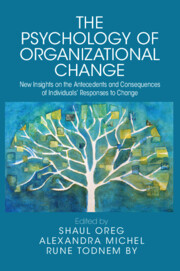 The Psychology of Organizational Change
The Psychology of Organizational Change Book contents
- The Psychology of Organizational Change
- The Psychology of Organizational Change
- Copyright page
- Contents
- Contributors
- Part I Introduction
- Part II The Evolution of Change and Its Responses
- Part III Change in Context
- Part IV The Development of Change Leadership
- Part V The Process of Change Leadership
- Part VI Conclusions and Commentary
- Index
- References
Part II - The Evolution of Change and Its Responses
Published online by Cambridge University Press: 28 September 2023
- The Psychology of Organizational Change
- The Psychology of Organizational Change
- Copyright page
- Contents
- Contributors
- Part I Introduction
- Part II The Evolution of Change and Its Responses
- Part III Change in Context
- Part IV The Development of Change Leadership
- Part V The Process of Change Leadership
- Part VI Conclusions and Commentary
- Index
- References
Summary

- Type
- Chapter
- Information
- The Psychology of Organizational ChangeNew Insights on the Antecedents and Consequences of Individuals' Responses to Change, pp. 13 - 92Publisher: Cambridge University PressPrint publication year: 2023


